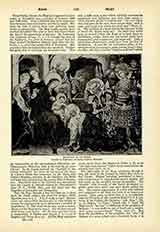
Maestro di Camera del Papa
The pope's chief chamberlain, whose authority extends over all matters concerning the daily personal service of His Holiness

Maestro di Camera del Papa. —In former times there were four so-called palace prelates (prelati palatini): (I) the Major Domo; (2) the Maestro di Camera; (3) the Auditor to the pope; and (4) the Master of the Sacred Palace. As the position of auditor had been allowed to remain vacant during the later years of Leo XIII’s pontificate, it was abolished as being superfluous at the beginning of Pius X’s reign. And when the major domo, Msgr. Cagiano de Azevedo, was raised to the cardinalate on November 11, 1905, the then maestro di camera, Msgr. Gaetano Bisleti, was promoted to the office of major domo; in the “Gerarchia Cattolica” for 1906 the office of maestro di camera is vacant, and a footnote says: “The duties of maestro di cam-era are temporarily transferred to His Excellency the Monsignor ‘Major Domo”. This state of affairs still continues, so that there are now only three palace prelacies and (as one official discharges the duties attached to two of these) only two palatine prelates. All three prelates have the right of residence in the Apostolic palace.
The maestro di camera is the real chief chamberlain. His authority extends over all matters concerning the daily personal service of His Holiness. He is the immediate superior of all the chamberlains, both clerical and lay; he has charge of the service of the Anticamera as regards the four acting clerical privy chamberlains; he informs the orderly officer of the Noble, Swiss, and Palace Guards respectively, of the hours of duty. for the next day; he summons the privy and honorary lay chamberlains to their period of weekly service, and dismisses them at the end of it. All petitions for audiences are lodged with him, whether they are presented to him immediately, or whether they are presented to him (in diplomatic language) mediately, by the Secretary of State. He issues the summonses to audiences, and regulates all occasional, unusual, or unofficial ceremonies, such as the reception of pilgrim-ages and the like. Being in daily personal touch with the pope, he receives his orders concerning the Anti-camera of the next day, and makes arrangements accordingly. As supernumerary Prothonotary Apostolic he is always at the head of this college of prelates irrespective of the date of his appointment. At papal audiences and on other occasions when the pope site upon his throne without pontifical vestments, the major domo stands on the right, the maestro di camera on the left, both on the second step of the throne. The extent of this prelate’s jurisdiction is limited exclusively to the reception rooms of the pope, from the first anticamera to the private apartments. He has also some ancient privileges, which may be read of in Humphrey, “Urbs et Orbis”.
PAUL MARIA BAUMGARTEN

